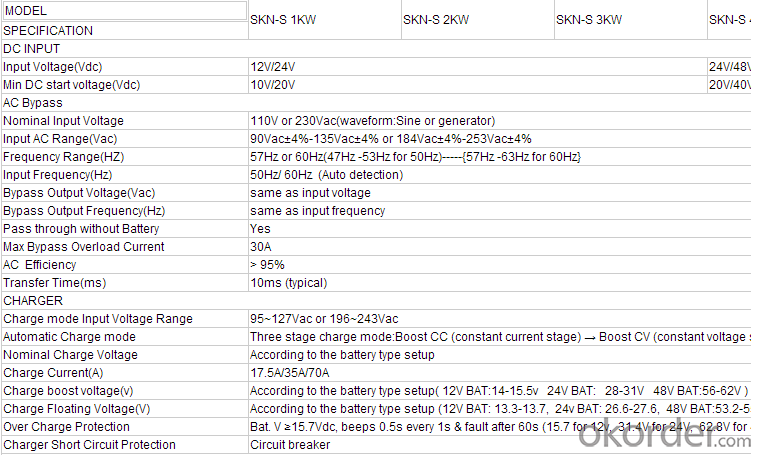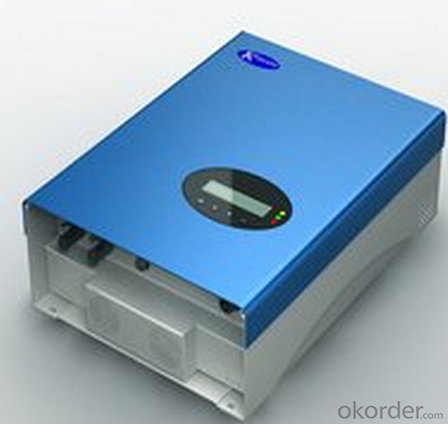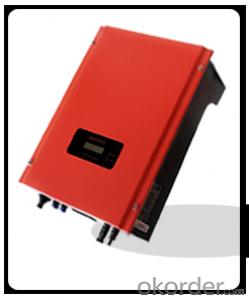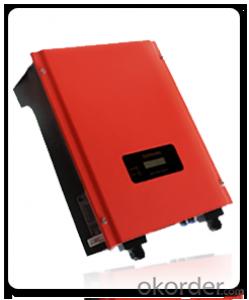Solar Inverters Sunteams 1500 to 3000 US ETL from China
- Loading Port:
- China main port
- Payment Terms:
- TT or LC
- Min Order Qty:
- 1 watt
- Supply Capability:
- 10000000 watt/month
OKorder Service Pledge
OKorder Financial Service
You Might Also Like
Description:
The Sunteams (US) 1500 ~5000 series isapplicable to various rooftops and small scale photovoltaic grid connected power plants. Their nominal output powers are 1.5 kW, 2 kW, 2.5 kW, 3 kW, 4 kW and 5kW respectively with Certificate ETL (220V/60HZ).
This series is transformerless and has a wide range of MPPT input voltage. Itsmaximum conversion efficiency and MPPT tracking accuracy reach 97.6 % and 99.5% respectively. The maximum DC voltage reaches 550 V. Its multilingualLCD display facilitates easy operation. It has waterproof direct plug-interminals. It has overvoltage, islanding, short-circuit, overloading andoverheating protection functions. Its IP65 protection degree will ensure itruns well in various tough environments.
These units are available with or without wirebox.


FAQ:Pls introduce more about CNBM?
CNBM is a China state owned company ,one of Global Fortune 500 .
- Q:How is the size of a solar inverter determined?
- The size of a solar inverter is determined based on the maximum power output of the solar panels connected to it. It should match or exceed the total capacity of the solar panels to ensure optimal performance and avoid any power limitations.
- Q:How does a solar inverter handle voltage and frequency variations caused by voltage sags and swells?
- A solar inverter handles voltage and frequency variations caused by voltage sags and swells by monitoring the input voltage and frequency constantly. When it detects a variation, it employs internal control mechanisms to adjust the output voltage and frequency accordingly. This ensures that the solar inverter delivers stable and reliable power to the connected load, even during voltage fluctuations.
- Q:Can a solar inverter be used in extreme weather conditions?
- Yes, solar inverters are designed to withstand a wide range of weather conditions, including extreme heat, cold, humidity, and even harsh environmental factors. They are built to be durable and reliable, ensuring their functionality and performance in various climates and weather conditions.
- Q:How does the weight of a solar inverter affect its installation process?
- The weight of a solar inverter can affect its installation process in a few ways. Firstly, a heavier inverter may require additional structural support or mounting equipment to ensure it is securely installed. This could involve reinforcing the mounting surface or using specialized brackets or racks. Secondly, the weight of the inverter may impact the ease of handling and maneuvering during installation, especially if it needs to be installed in elevated or hard-to-reach areas. Lastly, the weight can also impact the overall logistics of the installation, including transportation, lifting, and positioning of the inverter.
- Q:Can a solar inverter be used with a solar-powered remote sensing system?
- Yes, a solar inverter can be used with a solar-powered remote sensing system. The solar inverter is responsible for converting the direct current (DC) generated by the solar panels into alternating current (AC) that can be used to power the remote sensing system.
- Q:What is the role of a solar inverter in a residential system?
- The role of a solar inverter in a residential system is to convert the direct current (DC) electricity produced by solar panels into alternating current (AC) electricity that can be used to power household appliances and be fed back into the grid if there is excess energy. Additionally, the inverter ensures the efficiency and safety of the system by monitoring and regulating the flow of electricity.
- Q:Are there any maintenance requirements for solar inverters?
- Yes, there are maintenance requirements for solar inverters. While solar inverters are generally reliable and require minimal maintenance, regular inspections and maintenance are still necessary to ensure optimal performance and longevity. Some common maintenance tasks for solar inverters include: 1. Regular cleaning: Dust, dirt, and debris can accumulate on the surface of the inverter, potentially affecting its cooling capabilities. Regular cleaning helps to prevent overheating and ensures efficient operation. 2. Visual inspection: Regularly inspecting the inverter for any signs of damage, loose connections, or corrosion is important. This can be done visually to identify any issues that may affect its performance. 3. Firmware updates: Manufacturers often release firmware updates to improve the performance and functionality of the inverter. It is recommended to regularly check for and install these updates to ensure the inverter is operating at its best. 4. Monitoring system performance: Utilizing a monitoring system allows for the continuous monitoring of the inverter's performance. Any abnormalities or issues can be identified promptly, enabling quick maintenance or repair. 5. Professional maintenance: It is advisable to have a professional solar technician inspect and maintain the inverter at least once a year. They can perform more in-depth inspections, test the inverter's electrical connections, and troubleshoot any potential issues. By following these maintenance requirements, solar inverters can continue to operate efficiently and reliably, maximizing the benefits of solar energy production.
- Q:How do you choose the right output voltage for a solar inverter?
- When choosing the right output voltage for a solar inverter, it is crucial to consider the specific requirements of the electrical appliances or systems that will be powered by the inverter. The output voltage must match the voltage requirements of the devices to ensure compatibility and efficient operation. Additionally, the local electrical grid standards and regulations should be taken into account, as certain regions may have specific voltage requirements. It is advisable to consult with a professional or an electrician who can assess the specific needs and provide guidance in selecting the appropriate output voltage for the solar inverter.
- Q:Are there any maintenance requirements for a solar inverter?
- Yes, solar inverters require regular maintenance to ensure optimal performance and longevity. This typically includes cleaning the unit and its surroundings to prevent dust buildup, checking for any loose connections or wiring issues, inspecting for physical damage, and monitoring the inverter's performance through regular system checks. Additionally, firmware updates and software upgrades may be necessary to enhance efficiency and address any potential issues.
- Q:What are the safety considerations when installing a solar inverter?
- When installing a solar inverter, there are several important safety considerations to keep in mind. Firstly, it is crucial to ensure that the power supply to the inverter is completely disconnected before beginning the installation process. This helps to prevent any electrical shocks or accidents. Additionally, it is important to follow the manufacturer's instructions and guidelines precisely to ensure a safe installation. Another key safety consideration is to make sure that the inverter is properly grounded to prevent the risk of electrical faults or fires. Finally, it is advisable to work with a qualified and experienced electrician to ensure that the installation is done correctly and in compliance with local electrical codes and regulations.
1. Manufacturer Overview |
|
|---|---|
| Location | |
| Year Established | |
| Annual Output Value | |
| Main Markets | |
| Company Certifications | |
2. Manufacturer Certificates |
|
|---|---|
| a) Certification Name | |
| Range | |
| Reference | |
| Validity Period | |
3. Manufacturer Capability |
|
|---|---|
| a)Trade Capacity | |
| Nearest Port | |
| Export Percentage | |
| No.of Employees in Trade Department | |
| Language Spoken: | |
| b)Factory Information | |
| Factory Size: | |
| No. of Production Lines | |
| Contract Manufacturing | |
| Product Price Range | |
Send your message to us
Solar Inverters Sunteams 1500 to 3000 US ETL from China
- Loading Port:
- China main port
- Payment Terms:
- TT or LC
- Min Order Qty:
- 1 watt
- Supply Capability:
- 10000000 watt/month
OKorder Service Pledge
OKorder Financial Service
Similar products
New products
Hot products
Hot Searches
Related keywords































